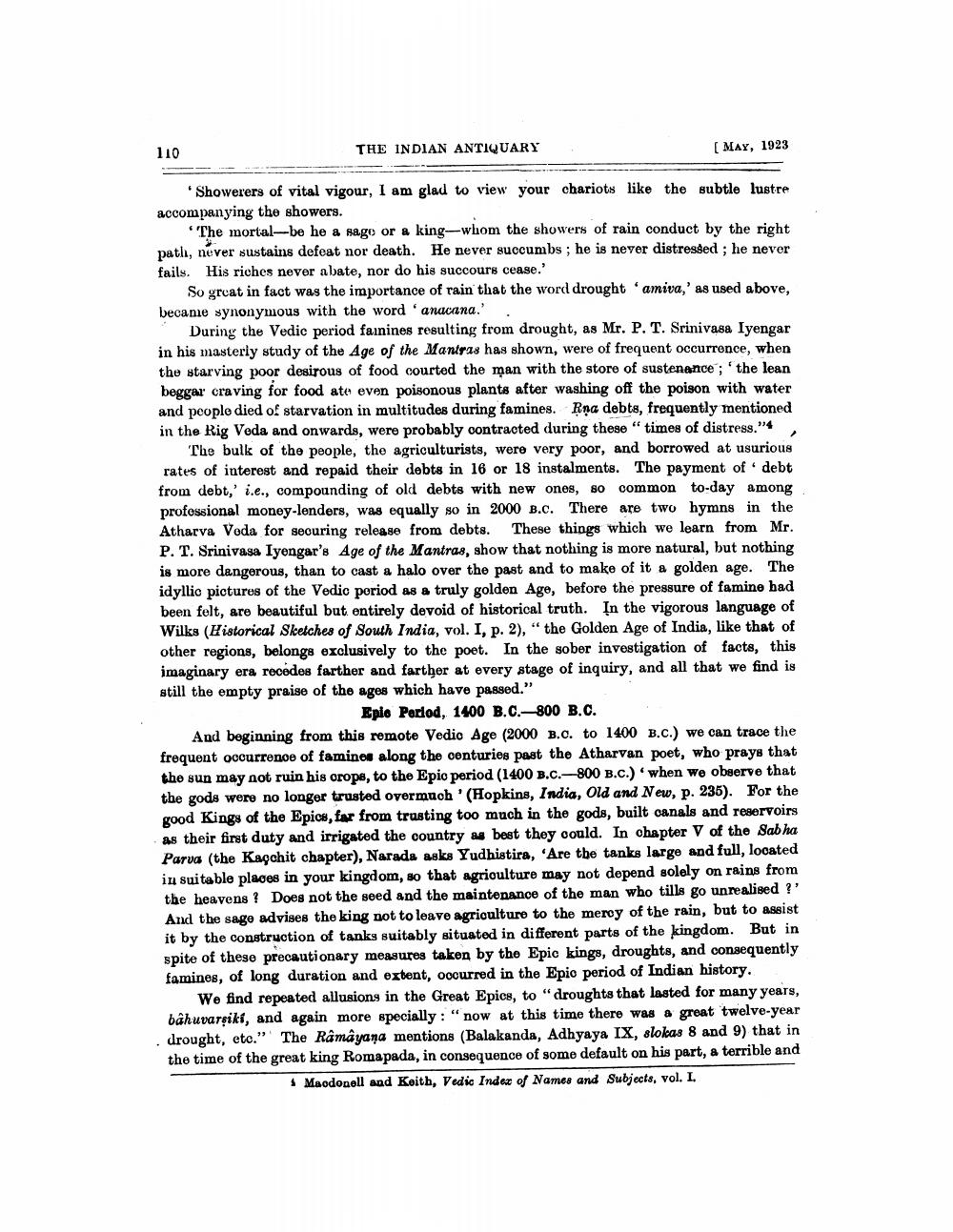________________
110
THE INDIAN ANTIQUARY
[ MAY, 1923
'Showerers of vital vigour, I am glad to view your chariots like the subtle lustre accompanying the showers.
The mortal-be he a sage or a king-whom the showers of rain conduct by the right path, never sustains defeat nor death. He never succumbs; he is never distressed; he never fails. His riches never abate, nor do his succours cease.'
So great in fact was the importance of rain that the word drought 'amiva,' as used above, became synonymous with the word 'anacana.'
During the Vedic period fainines resulting from drought, as Mr. P. T. Srinivasa Iyengar in his masterly study of the Age of the Mantras has shown, were of frequent occurrence, when the starving poor desirous of food courted the man with the store of sustenance; the lean beggar craving for food ate even poisonous plants after washing off the poison with water and people died of starvation in multitudes during famines. Ṛna debts, frequently mentioned in the Rig Veda and onwards, were probably contracted during these "times of distress."4
The bulk of the people, the agriculturists, were very poor, and borrowed at usurious rates of interest and repaid their debts in 16 or 18 instalments. The payment of debt from debt,' i.e., compounding of old debts with new ones, so common to-day among professional money-lenders, was equally so in 2000 B.C. There are two hymns in the Atharva Veda for securing release from debts. These things which we learn from Mr. P. T. Srinivasa Iyengar's Age of the Mantras, show that nothing is more natural, but nothing is more dangerous, than to cast a halo over the past and to make of it a golden age. The idyllic pictures of the Vedic period as a truly golden Age, before the pressure of famine had been felt, are beautiful but entirely devoid of historical truth. In the vigorous language of Wilks (Historical Sketches of South India, vol. I, p. 2), "the Golden Age of India, like that of other regions, belongs exclusively to the poet. In the sober investigation of facts, this imaginary era recedes farther and farther at every stage of inquiry, and all that we find is still the empty praise of the ages which have passed."
Epie Period, 1400 B.C.-800 B.C.
And beginning from this remote Vedic Age (2000 B.C. to 1400 B.C.) we can trace the frequent occurrence of famines along the centuries past the Atharvan poet, who prays that the sun may not ruin his crops, to the Epic period (1400 B.C.-800 B.C.) when we observe that the gods were no longer trusted overmuch ' (Hopkins, India, Old and New, p. 235). For the good Kings of the Epics, far from trusting too much in the gods, built canals and reservoirs as their first duty and irrigated the country as best they could. In chapter V of the Sabha Parva (the Kaçchit chapter), Narada asks Yudhistira, 'Are the tanks large and full, located in suitable places in your kingdom, so that agriculture may not depend solely on rains from the heavens? Does not the seed and the maintenance of the man who tills go unrealised?' And the sage advises the king not to leave agriculture to the mercy of the rain, but to assist it by the construction of tanks suitably situated in different parts of the kingdom. But in spite of these precautionary measures taken by the Epic kings, droughts, and consequently famines, of long duration and extent, occurred in the Epic period of Indian history.
We find repeated allusions in the Great Epics, to "droughts that lasted for many years, bâhuvarṣiki, and again more specially: "now at this time there was a great twelve-year . drought, etc." The Râmâyana mentions (Balakanda, Adhyaya IX, slokas 8 and 9) that in the time of the great king Romapada, in consequence of some default on his part, a terrible and
Maodonell and Keith, Vedic Index of Names and Subjects, vol. I.




